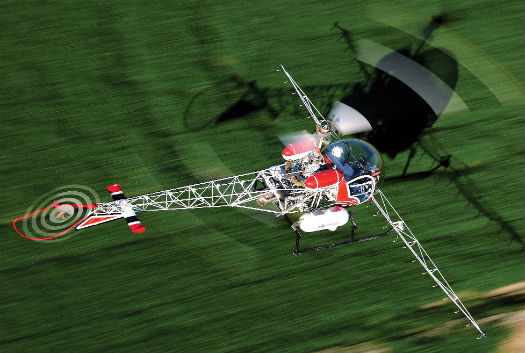
A growing number of fixed-wing agricultural (ag) operators are adding helicopters to their fleet. They can realize the benefits only if they go into this discipline with a clear understanding of the risks and costs involved. Skip Robinson Photo
Aviation has been helping support and protect the world’s food supply for over 90 years, but when many people think about the type of aircraft that complete this important task, it’s the airplane that usually comes to mind. This is for good reason; roughly 83 percent of the agricultural (ag) aviation fleet is comprised of fixed-wing aircraft. Since this is a helicopter-oriented publication, I’m sure it comes as no surprise that the remaining 17 percent of the aerial application fleet is rotary-wing.
Although it’s certainly acceptable for spraying wide open fields, the helicopter really comes into its own when the crops are tucked into smaller or confined areas. Uneven terrain, locations impacted by urban or industrial sprawl, or fields affected by the ever growing number of wind farms are among the list of candidates for ag helicopters.
For as many reasons as there are to justify the use of helicopters in an aerial application business, there are an equal number of important operational and cost factors to be considered. Vertical visited operators from Pennsylvania to California to learn more about the risks and benefits of this specialized industry segment — and to find out what you need to know if you’re contemplating starting your own ag helicopter operation.

The increasing number of wind turbines have led to more growers demanding helicopters to spray their fields.
What does a helicopter offer?
One of the main reasons to operate a helicopter in an ag environment is to gain access to tight areas. Not only are these either difficult or impossible to spray with airplanes, but a helicopter can be more friendly to the public. By being able to stay within the confines of a field, helicopters can, at times, eliminate the need to turn over roads and houses. In essence, it allows you to fly neighborly.
“You can have a good visual of the traffic going up and down the road and you can circle around until the traffic is clear then hit the pass along the road where there is no impact on the vehicles,” said Glenn Martin, VP of Helicopter Applicators, Inc. in Gettysburg, Penn. “You can make those short clean-up passes along the tree lines, as well as make sharp turns and follow the confines of the field boundary. This makes it a complete job when you use the helicopter in these kinds of areas.”
Another major factor in the choice to put helicopters into spraying service is wind farms. “I have been forced into helicopters due to the wind farms — the farmers are demanding it,” said John Townsend, president of Townsend Aviation of Monticello, Ind. “If it hadn’t been for the wind farms, we wouldn’t be operating helicopters today.”

Highly-specialized platform trucks allow operations to be set up right at the application area, thus eliminating the need for ferry flights to restock the helicopter.
Many operators who spray with airplanes find that adding the helicopter to their offering can bring either additional work to the table from their existing customers, or work from new customers that they couldn’t service with the airplane.
For some ag operators, the helicopter can also offer a significant logistical advantage. “With helicopters, you can set up right on the field,” explained Ray Pojanowski, safety director at San Joaquin Helicopters, based in Delano, Calif. “The highly specialized platform trucks are a full service station for the ag helicopter. You can mix and load chemicals right there at the job, as well as refuel the helicopter, thus eliminating the need to return to the operations base for reloading and refueling — as is usually the case with airplanes.”
Martin praised the productivity of his rotary-wing aircraft. “We spray contours, we spray hills, [and] we spray over mounds of uneven terrain,” he said. “The other advantage of a helicopter is that you don’t always have to spray with them — you can do lift or part 135 work with them.”
But clearly, when considering the use of helicopters, the environment must make sense; airplane operators are going to find out quite quickly how expensive a helicopter is to maintain. “That’s the biggest shock,” said Townsend. “I was astounded by the costs compared to an equivalent cost airplane. I know the piston helicopters are a little cheaper to operate. But nevertheless, the cost, and the maintenance, and keeping an eye on things are of utmost importance in a helicopter, because there is so much going on with the equipment.”
Yes, if you do your homework, you should be well aware of the cost of the ship and its time-related components, but who among us hasn’t been surprised by unscheduled maintenance or a new service bulletin or airworthiness directive? And unless engine related, these surprises are typically much more costly with a helicopter. This is why maxing out your budget on the purchase price and not setting aside a substantial maintenance reserve can be the one critical make or break move in your decision to operate a helicopter.
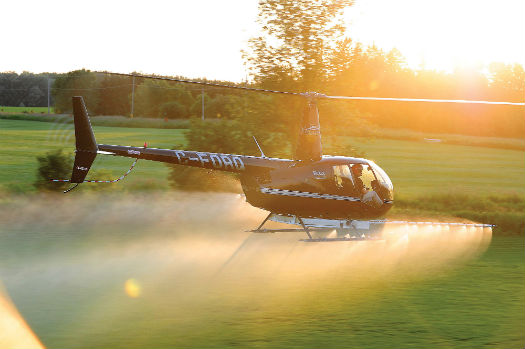
The Robinson R44 has been quickly growing in popularity for use in aerial application work. Mike Reyno Photo
In ag helicopter work, you may do 50 to 60 takeoffs and landings in a day. And this kind of flying means that the engine is going from 70 to 100 percent power every 30 seconds or so — and the tail rotor and its components take a real beating, too.
A common field support practice for many ag helicopter operators is to utilize a semi-truck with two storage tanks and a landing pad on top. “That’s one of the best things an operator can do to stay out of foreign material,” said Townsend. “Landing on an elevated pad is essential.”
The field support truck also keeps the tail rotor safe. And since they are often parked on country roads, they don’t prevent the passage of vehicles.
Of course, the higher costs to maintain and support the helicopter need to be transferred to the rates per acre the operators charge their growers — an operator has to be profitable. So, if a grower wants a helicopter, they must also understand that they are going to have to pay more money for it.
“In my mind I want it to be a safe and effective tool and give the customer the best,” said Townsend. “I fly both [airplanes and helicopters], I make payments on both of them — I want them to both to be profitable.”
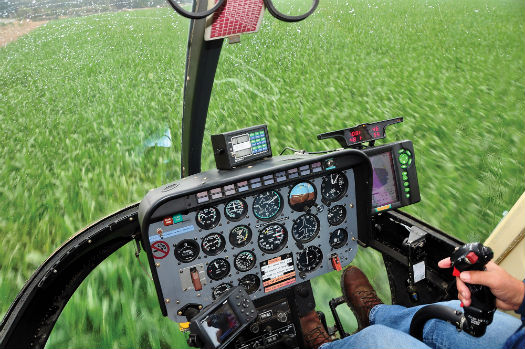
Today’s ag aircraft are full of high-tech gear that can sometimes challenge the pilot’s primary need to keep his or her eyes outside. Skip Robinson Photo
Although operators can pick up extra business with a helicopter, they have to realize that it still has limitations. There are going to be fields, even with a helicopter, that have to be turned down. These could be next to a housing tract or area of urban encroachment, or very tight spaces with lots of wires.
“There are going to be times when you just have to say ‘no’ — even with a helicopter,” Pojanowski said. “You need to make sure you are getting the helicopter for the right reasons.”
The importance of training
Recent statistics from the National Agricultural Aviation Association (NAAA) revealed that even though helicopters comprise only 17 percent of the ag aviation fleet, they accounted for 28 percent of the accidents and 36 percent of the fatal accidents in 2014. “One of my concerns centers on those fixed-wing ag operators who after a few good years and having some money to spend, decide they want to buy and learn to fly a helicopter,” said Ken Degg, director of education and safety for the NAAA. “Once they’ve learned to fly the helicopter, they then decide to use it in their ag business without really being prepared for it.”
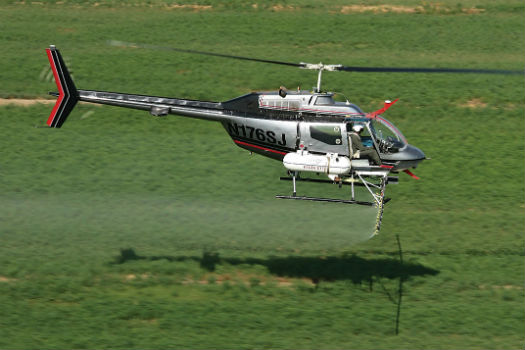
A huge advantage for helicopter ag operators is that new pilots can be accompanied by an experienced pilot to train them properly.
Top on the list of operational priorities for all those who Vertical visited was properly training their pilots. “You need to really focus on the training and not make assumptions about what the pilot does or doesn’t know,” said Pojanowski.
A critical part of this is knowing what the ground crew is responsible for. The pilot has to know what they are dealing with in the field so they can have a good working relationship.
“Regardless of the pilot’s flying background — tours, EMS [emergency medical services], military — with ag flying it’s a whole new ball game,” said Townsend. “They are operating in a low environment — it becomes fun and intoxicating.”
I think we all know how that feels when flying helicopters. But, as Townsend cautioned, “When you turn somebody loose and they are on their own out in a corn or bean field 50 miles from base, it’s pretty easy to start experimenting and seeing what you can do with this bird — that’s when things go wrong. A person has to be able to check his ego back at the office, and stay on track, [be] vigilant, and get an early set of habits to stay safe.”
Townsend’s son, Brian, is among the pilots in his operation. “In the Army, I did a whole lot of intense flying — extreme stuff, mountains [and] unaided dark,” said Brian Townsend. “But for the most part, you didn’t spend a whole lot of time eight feet off of the ground. And when you get into that low altitude range, it’s a whole other animal. . . . The amount of time we spend in that danger area of helicopters elevates the opportunity for something bad to happen.”
Operators have to devote the training time for new pilots to make sure they are forming a good basis — so that when they are turned loose into the system, operators and growers can trust them to do the right thing.
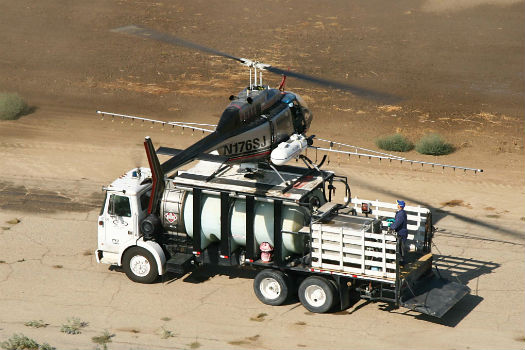
Platform trucks allow the helicopter to remain above the dust and debris — significantly reducing the wear and tear on critical components and the engine.
Martin said his training routine sees first year pilots receive easy fields with no wires — then they advance to wires across the roads, and eventually with wires across the fields. “The next step is to deal with high tension lines, trees and houses,” he said. “You have to take them over every scenario out there that you can possibly do, within the environment you work in.”
Pojanowski said it was important to establish some kind of training schedule. “What are you going to do with that pilot? How are you going to bring him up?” he asked. “[You need to do it] step by step — increasing the tasks and level of difficulty and bringing him along to being the ag pilot you want him to be. It’s not an easy process, and it’s not a quick process.”
When it comes to training new pilots, one significant advantage ag helicopter operators have is the ability to actually fly with them. The huge majority of fixed-wing ag aircraft are single seat — and therefore do not offer this opportunity.
Accordingly, the training process at San Joaquin Helicopters begins with landing on the support truck — done as dual instruction. Then the pilot does this repetitive times flying solo. This is followed by dual instruction flying in wide open fields, before obstacles are introduced.
The next step is to practice flying half loads of water on and off the truck, then it’s spraying with half loads of water. Next, it’s back to the field with half loads of spray, before the new pilot is finally turned loose with a full gross weight load of spray off the loading truck. “I want that pilot to experience the aircraft in different loading conditions, and I want him to understand the entries and exits to fields with a fully loaded aircraft,” said Pojanowski.
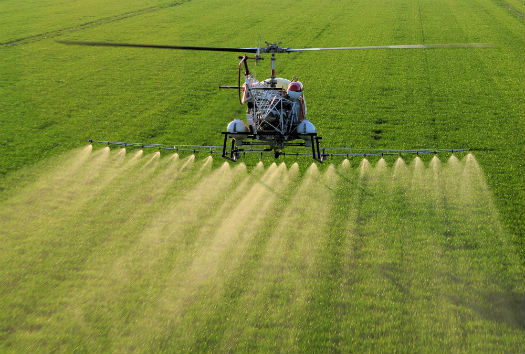
Experienced operators all advise that new helicopter ag pilots get plenty of experience flying in wide open fields first, before being introduced to those including obstacles and confined areas. Skip Robinson Photo
Safety First
Usually helicopters are bought for operating in the confined areas, and that’s all well and good. But it would be beneficial if new operators would run them for a while in big open fields so that they can find out what this kind of flying is all about.
“It can be so fun, and you can realize that there is nothing better than this,” said Brian Townsend. “Then, in a moment, it can switch to something where you wonder what just happened and how did I survive this? It just scared the crap out of me!”
One easy trap for an operator to fall into when it comes to pilot training is to get into the position where they think, ‘I really need this guy — so I’m going to put him out there.’ “That’s wrong for you to do — and it’s wrong to do [that] to that pilot,” said Pojanowski. “Make sure you have gone through all the steps.”
Dave Kerr, who has been a pilot at San Joaquin for three years, said: “I didn’t feel any [training] pressure. It wasn’t even brought up in the discussion. There was never any, ‘You need to accomplish this amount in this amount of time.’ And to this day it’s never been brought up.”
Brian Townsend added that it was important to take such pressure off pilots, so they feel able to stop flying when they’re no longer comfortable. “Don’t be afraid to not do something,” he said. “You don’t have to go under the wires; you don’t have to spray those 20 acres because it’s on a bad side of wires.”
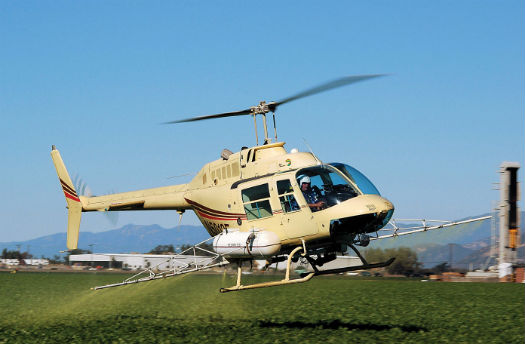
Ag work is done down low, which leaves little reaction time if something goes wrong. This is why turning a new pilot loose too soon can end up with devastating results. Skip Robinson Photo
It’s easy for a pilot to feel they have to finish a field simply because they have a job to do. But the operators Vertical spoke to would agree that a grower would rather his or her 20 acres get missed on purpose, than have to scoop a wreck out of his field with a bobcat. “Those pilots who know when to say ‘no’ will be spraying many acres, and make up for it in the long run,” said Brian Townsend.
As John Townsend put it, “[Helicopter ag] is a venture that’s a serious undertaking. Someone who wants to get into the ag helicopter business needs to listen to a mentor, or someone who’s been in the ag helicopter business for a long time — because it just might save their life.”
Getting into helicopter ag operations is a decision that must be made for the right reasons and not taken lightly. Careful planning must be made for the financial and logistical aspects of utilizing helicopters in an ag setting. And above all else, you must make sure the pilots are brought along properly and patiently.
“Do that and you will end up with a competent pilot who will treat your aircraft the way he is supposed to, he will treat your crew like he is supposed to, and he’s going to get the job done the right way with no drift claims and he’s going to make your customer happy,” said Pojanowski. “And that’s the ultimate goal.”





